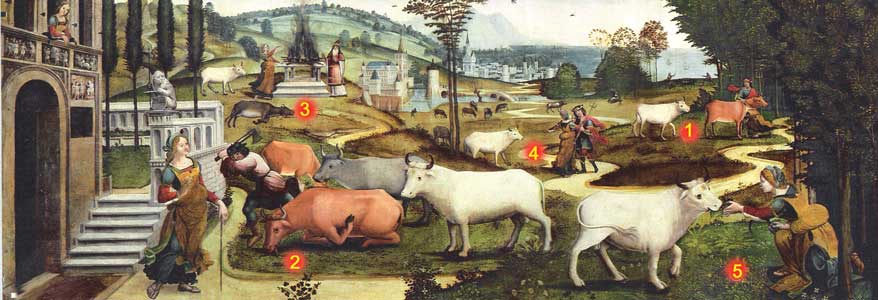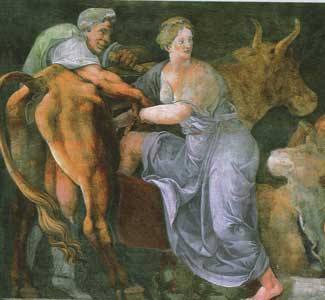.
In Greek mythology, Pasiphaë (or Pasiphae) ( Πασιφάη ) was the daughter of Helios and Perseis and the sister of Circe. She was raised as a princess at Cholchis, and then given in marriage to King Minos of Crete.
With Minos, she was the mother of :
- Acalle (or Acacallis acording to Pausanias 8.53.4), Ariadne, Phaedra, Xenodice (daughters)
- Androgeus , Catreus, Deucalion (not related to the more known Deucalion and the flood) and Glaucus (sons)

The History of the Minotaur from Cassone Paintings,16th century., 0.69 m x 1.82 m, Musée du Petit Palais Avignon

Pasiphae entrers in Daedalus wooden cow, Giulio Romano c.1530. (A more terrible use was the real bronzen bull device build by Perillus of Athen, See: Phalaris) But angry at him for not sacrificing the bull, Poseidon made the animal savage, and contrived that Pasiphae should conceive a passion for it. In her love for the bull she found an accomplice in Daedalus, an architect, who had been banished from Athens for murder. He constructed a wooden cow on wheels, took it, hollowed it out in the inside, sewed it up in the hide of a cow which he had skinned, and set it in the meadow in which the bull used to graze. Then he introduced Pasiphae into it; and the bull came and coupled with it, as if it were a real cow. And she gave birth to Asterius, who was called the Minotaur. He had the face of a bull, but the rest of him was human; and Minos, in compliance with certain oracles, shut him up and guarded him in the Labyrinth Apollodorus, Library and Epitome 3.1.4
Pasiphaë was worshipped as an oracular goddess at Thalamae outside of Sparta. The geographer Pausanias describes the shrine as small, situated near a clear stream, and flanked by bronze statues of Helios and Pasiphaë. His account also equates Pasiphaë with Ino and Selene.
Cicero writes in De Natura Deorum that the Spartan Ephors would sleep at the temple to receive prophetic dreams to aid them in governance. According to Plutarch, Spartan society twice underwent major upheavals sparked by ephors' dreams at the shrine during the Hellenistic era. In one case, an ephor dreamed that some of his colleagues' chairs were removed from the agora, and that a voice called out "this is better for Sparta"; inspired by this, King Cleomenes acted to consolidate royal power. Again during the reign of King Agis, several ephors brought the people into revolt with oracles from Pasiphaë's shrine promising remission of debts and redistribution of land. (See Plutarch, Lives of Agis and Cleomenes)
The Story of Pasiphae, Theseus and the Minotaur
Art
Pasiphae falling in love with the bull sent by Neptune
before 1573, Etienne Delaune
Pasiphaë, 1943, Jackson Pollock
Pasiphaë Adorning the Bull with Flowers, 1891–1907. César-Isidore-Henry Cros
Links
For Pasiphaë the moon of Jupiter, see Pasiphaë (moon).
Apollodorus 3.1.2

H/S/F Pasiphae Palace of the Minoan Lines, named after Pasiphae
Literature
Rebecca Armstrong, Cretan Women. Pasiphae, Ariadne, and Phaedra in Latin Poetry. Oxford Classical Monographs. Oxford: Oxford University Press, 2006. ISBN 0-19-928403-2
| Ancient Greece
Science, Technology , Medicine , Warfare, , Biographies , Life , Cities/Places/Maps , Arts , Literature , Philosophy ,Olympics, Mythology , History , Images Medieval Greece / Byzantine Empire Science, Technology, Arts, , Warfare , Literature, Biographies, Icons, History Modern Greece Cities, Islands, Regions, Fauna/Flora ,Biographies , History , Warfare, Science/Technology, Literature, Music , Arts , Film/Actors , Sport , Fashion --- |
Retrieved from "http://en.wikipedia.org"
All text is available under the terms of the GNU Free Documentation License

